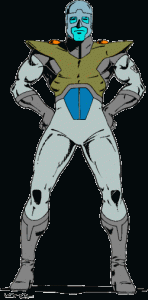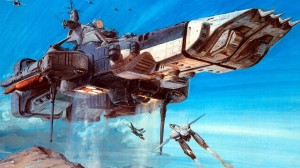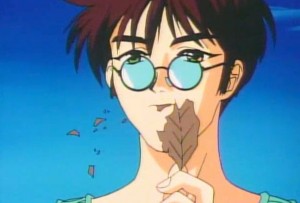 Over the past couple of weeks, I caught the nostalgia bug, bad, after finding a cheap copy of Macross Triangle Frontier on Amazon and digging into the original series timeline first. Not necessarily for Macross, but for my gateway drug into it- the American-localized animated series known as Robotech. It just so happened that my local library even had the series on DVD, so I decided it was high time I re-watched it for the first time since Toonami aired it.
Over the past couple of weeks, I caught the nostalgia bug, bad, after finding a cheap copy of Macross Triangle Frontier on Amazon and digging into the original series timeline first. Not necessarily for Macross, but for my gateway drug into it- the American-localized animated series known as Robotech. It just so happened that my local library even had the series on DVD, so I decided it was high time I re-watched it for the first time since Toonami aired it.
Robotech seems to have an iffy reputation these days. Anime is widely available in its original audio with subtitles that at least pretend to be accurate, and even some cable networks have overcome their fear of playing intro songs in their native state. But back in the late eighties and early nineties, Japanese animation was only beginning to approach mainstream audiences- well, if you ignore the fact Japanese studios were doing the grunt work for shows like GI Joe and Transformers. So, people can say all they will about the late Carl Macek and some of the liberties he took with shows, he got them through to an audience, even if compromises were made to appease networks, marketers, and so on. I can only imagine the sort of widespread forum bitching that would arise in the internet age if somebody tried to splice a trio of unrelated but thematically similar anime series for American airwaves now that people have an easier time accessing information on shows they might be interested in.
I make this long-ass digression because, for the uninitiated or well, too young at this point, Robotech was actually made up of three different “Real Robot” mecha anime series, with some edits and rewriting to make them appear to be different generations participating in the same over-arcing saga. The reason for this (as well as the treatment given to Harlock, for another example) was the need to meet a minimum episode count in order to be syndicated. After experiencing both the Robotech “Macross Saga” and Macross’s own sprawling franchise, I get the distinct impression that their goal was more or less to get Macross on American TV, and to hell with the other series (Superdimensional Cavalry Southern Cross and Genesis Climber Mospeada.) If you compare the amount of editing and rewriting done to each respective series, Macross gets off very light, with surprisingly few name changes or even censoring. (The only “deleted scene” I can think of offhand involves a mother throwing her baby to a friend who asked to hold her.) By contrast, Southern Cross wasn’t even originally intended to take place on Earth, and Mospeada’s adventure takes the heroes through numerous cities that probably shouldn’t be as intact as they are after the events of Macross.
I’ve been percolating just how to tackle this, since it’s a show I loved since I was a kid and it makes a nice companion to MYGames, but I couldn’t really decide on a tone or angle. Eventually, the easiest option seemed like the best- since I want to say how much I love Robotech- as its own ‘thing’- I’ll just offer my overall take on the setting and how well things have held up after all this time.
I. PROTOCULTURELOGUE
As said before, the original Macross and Robotech’s Macross Saga mostly follow the same story. The biggest divergence is the definition of the word “Protoculture.” In Macross, the Protoculture was an ancient race, responsible for sowing all sorts of creations throughout the cosmos. The warrior giants, the Zentraedi were warned in legends that they shouldn’t interfere with ‘cultured’ societies, ultimately because their original masters wanted them to learn there was more beyond constant warfare so they would be easier to control. In Robotech, however, Protoculture is basically a magical super-fuel and the MacGuffin that ties the entire saga together. It creates sort of a philosophical split between a spiritual “Love and music will conquer all!” approach to space warfare and an arguably more Western friendly nuts and bolts approach.
Personally, even though Harmony Gold, the series’ owners have moved the Jack McKinney novelizations into “secondary canon” because they wanted Shadow Chronicles to be something of a fresh start, I consider the novels to be the ‘truest’ Robotech universe. Freed from trying to paste found materials into a coherent mess, the novels follow a more consistent tone, fleshing out lots of little details, and even adding the concept of Protoculture itself having a hand in events via metaphysical forces known as “The Shapings.” Granted, when they run out of existing framework and are allowed to create new material, shit gets a bit… weird.

I also used to be a big fan of the Robotech RPG, by Palladium and used to bug my cousin if his comic shop had any new Palladium catalogs show up as a pre-Internet way to see if there had been any new releases. My enthusiasm died off as I got to the expanded universe material. As I mentioned before in my Battlecry review, I hate that so much Robotech fiction takes place within the post-war reconstruction time period, where malcontent Zentraedi warriors who didn’t want to integrate with humanity were attempting rebellions left and right. In more mainstream nerd terms, It’s the Dungeons and Dragons “you are walking in a forest” setup of the Robotech universe, and frankly, for my time and money the only good story to come of it was Zaria’s attempt to use jerry-rigged biochemical weapons in The Zentraedi Rebellion. And that may have just been because I thought the idea of her having a robot suit to control another robot suit meant for giants was neat at the time. Though the Veritech Car was a pretty big slap in the face, the sheer fucking boringtude of sourcebooks that amounted to “Here is what Africa is like during the reconstruction!” killed it for me. However, the Palladium RPG *did* introduce me to Macross II, which in turn lead me to seek out the videos and discover the anime wall at Suncoast. Ah, those sweet and sour days of youth…
As an aside, the Macross II Deck Plans books that came out as a companion to the M2RPG were my first exposure to Dream Pod 9, the makers of Heavy Gear, and god, even *that* bit of hired work shows their signature touch. So many RPG books’ artwork was horribly inked black and white line art, presumably traced from the animation model sheets, while DP9 used tone screens and attempted to make interesting page layouts. In addition, there was a sample storyline split into parts in the back of each book as a little extra treat for gamers who got their hands on all of them.
 II. THE MACROSS SAGA, REVISITED
II. THE MACROSS SAGA, REVISITED
Robotech opens in the far future year of 1999 (er), when a massive alien starship crash-lands on a remote island in the Pacific. The knowledge we’re not alone in the universe improbably halts the near-constant state of war humanity has fallen into, and the following years are spent both reconstructing the vessel and reverse engineering its secrets. The end product is Robotechnology, and the rebuilt ship, the Super Dimensional Fortress One (SDF-1, or simply the titular Macross in Japanese) and the transforming fighter planes dubbed Veritech Fighters. Unfortunately, a race of genetically-engineered warrior giants called the Zentraedi are rapidly nearing Earth, in pursuit of the ship and the secrets hidden within its hull. When they near Earth, a built in program causes the SDF-1’s main cannon to go off, intended as a trap for its pursuers. With that shot, the First Robotech War begins.
As mentioned before, it definitely feels like Macross got the most attention during the translation process, and it’s pretty handily the fan favorite arc as well. And you know what? It really is a good story. Putting it beside its stepsiblings is kind of unfair. I do have a soft spot for New Generation/Mospeada (Can you believe Yoshitaka Amano was credited with character design? In retrospect… yeah, I can.) In re-watching part of the series with my girlfriend, I can say two things-
1) In my opinion, the animation itself doesn’t hold up that great, but there’s a sort of ambition to it- smirk at the off model moments as you please, but they seem to make an effort not to recycle too much footage, at least overtly.
2) The story itself holds up pretty nicely.
To elaborate on 2, I think the key is that it does feel as though the show is focused on telling a story first, and putting “TO SELL TOYS” a bit further down the list to focus on character development. In particular, the series actually has the feel of a disaster movie rather than a stock war drama or good versus evil formula common to cartoons at the time. Airing alongside things like GI Joe and Transformers, where nobody ever got seriously hurt unless it was The Movie edition, it’s amazing to see how much death and devastation occurs- possibly more often through equipment fucking up than the fleet of bloodthirsty giants hounding them at every turn. You could make a drinking game for every time the SDF-1 malfunctions and screws the crew over, especially early on. By the end of the first handful of episodes, a failed space fold (fancy word for hyperdrive) has deposited the crew outside of Pluto’s orbit, in a ship they only *kind of* know how to control, pursued by aforementioned space giants, and now with an unexpected cargo hold full of civillians they had to rescue from the island they accidentally warped into space along with the ship. Add to this the fact the main character doesn’t get official “fighter pilot hero” status until several episodes in, and you can see that the production is focused on developing things, and not immediately rushing to show off the next shiny object to be sold by Bandai at a retardulous price to piss me off. A continuing narrative was also almost completely mind-blowing to see alongside other cartoons which were almost purely episodic, with one or two two-parters to mix it up.
I found the characters to be pleasantly understated compared to what’s the norm these days, too. Nobody feels like they’re written or designed to inspire internet memes and sell girly dolls. I remembered Minmei as an obnoxious, cartoonishly annoying character people inexplicably love, and seeing it again now, it’s not that she’s that *terrible,* she’s mostly plain selfish and inconsiderate, but nice beneath it. You can see why Rick likes her early on, and that makes their increasing distance sympathetically frustrating, rather than contrived rom-com misunderstanding frustrating. Roy is the cool, older ‘big brotherly’ type, but not totally flawless either. And I don’t mean that in a secretly brooding over a dark secret way, I mean that in the way the very first episode has a short scene where he fumbles with a mic stand. See? Even Mr. Awesome can fuck up. But it’s not like he neglects to check into an infirmary after a heated dogfight so he can play guitar for his girlfriend, right?
…Face it, pineapples are ruined.
Lisa Hayes (a pretty respectable substitute for “Misa Hayase” in the name swap department, really) is the third point of the love triangle that forms around Rick. She’s a strait-laced army brat who serves on the bridge of the SDF-1. Initially despising him, they warm up to each other over time and become the One True Pair, a fact that the narrator kind of prematurely spoils the first time he looks at her in a way other than “What the hell is with her?” Actually, it’s kind of creepy because the narrator makes it sound like he finds her attractive because she’s *vulnerable* at the time and brought up so abruptly you’d almost expect Rick to turn to the camera and go “Wait, what?” Other stand-out characters include Rick’s wingmen Max Sterling (Max Jenius) and Ben Dixon (Hayao Kakizaki- okay yeah, that’s a pretty big swap, as is Hikaru Ichijo into Rick Hunter, but at least they kept the ‘ick’ sound.)
The series finale (or season finale, I guess) marks the big splitting point between the source and the adaption. At the conclusion of the Macross Saga, the heroes of Earth begin planning to travel to the stars and attempt to meet the Zentraedi’s masters, who seek the Matrix of Le-Protoculture Matrix from the hull of the SDF-1. Rick and company’s journey leaves the Earth in the fat and stupid hands of Anatole Leonard and the Army of the Southern Cross, and in one final “whoops” moment, it seems that they and the Masters’ fleet were both in transit and miss each other along the way. The Second Robotech War looms. In the original, they simply plan to venture into space looking for new worlds to colonize, which sets up the setting of the sequels (other than II, which makes it seem that, much like in the real world, man set forth into space, got bored, and came back home to wallow in its own filth a while more.)
III. TO THE SEQUELS
Back across the ocean, Macross’s popularity leads to a movie adaptation entitled Macross: Do You Remember Love? It in turn received a… questionable dub and was edited down a bit as MACROSS IN: CLASH OF THE BIONOIDS in the States. After a glorified music video called Flashback 2012, the original studio gave it a rest and Big West, the distributor had Macross II: Lovers Again produced as an OAV series that was later pared down into a movie edition. Less than satisfied with the result, Studio Nue returned to helm the amazing Macross Plus and the less amazing Macross 7, to be followed by the more current Macross Frontier series. (This of course is skipping the various canon and non-canon video games, manga, drama CD’s and all the other secondary fiction that clings to any Japanese property the way errant particles of cat litter stick to your feet.) DYRL is now considered to be a movie within the setting of the TV series, though some aesthetics from the movie find their way into the sequel material, and apparently Macross II is either a sequel to DYRL or its own parallel timeline entirely.

But back here, following the airing of the Southern Cross and New Generation, it’s not as though the Robotech franchise was ignored by Harmony Gold and allowed to stagnate, perpetuated only by Antarctic Press comic books, RPG sourcebooks and fan works or anything. They were busy producing two episodes of Robotech II: Lovers Ag-The Sentinels, I mean and canceling it before anything actually happened, suing people, and getting into the real estate business. Yes, that’s seriously them.
Well, I suppose I better work up the nerve to sit through The Robotech Masters and their shitty voice effects. The things I do for love.
